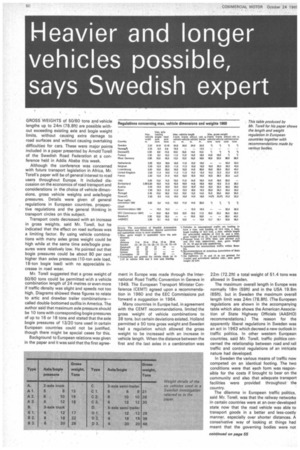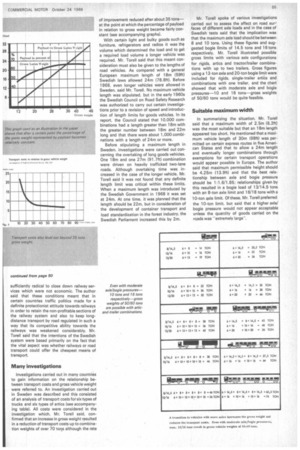Heavier and longer vehicles possible, says Swedish expert
Page 54

Page 59

If you've noticed an error in this article please click here to report it so we can fix it.
GROSS WEIGHTS of 50/60 tons and vehicle lengths up to 24m (78.8ft) are possible without exceeding existing axle and bogie weight limits, without causing extra damage to road surfaces and without causing overtaking difficulties for cars. These were major points included in a paper presented by Arnold Torell of the Swedish Road Federation at a conference held in Addis Ababa this week.
Although the conference was concerned with future transport legislation in Africa, Mr. ToreII's paper will be of general interest to road users throughout Europe. It included discussion on the economics of road transport and considerations in the choice of vehicle dimensions, gross vehicle weights and axle/bogie pressures. Details were given of general regulations in European countries, prospective regulations and the general thinking in transport circles on this subject.
Transport costs decreased with an increase in gross weights, said Mr. Tore'', but he indicated that the effect on road surfaces was a limiting factor. By using vehicle combinations with many axles gross weight could be high while at the same time axle/bogie pressures were relatively low. He pointed out that bogie pressures could be about 80 per cent higher than axles pressures 110-ton axle load, 18-ton bogie load) with no appreciable increase in road wear.
Mr. Torell suggested that a gross weight of 50/60 tons could be permitted with a vehicle combination length of 24 metres or even more if traffic density was slight and speeds not too high. Diagrams showed these figures to relate to artic and drawbar trailer combinationscalled double-bottomed outfits in America. The author said that maximum axle pressure should be 10 tons with corresponding bogie pressures of up to 16 or 18 tons and stated that the axle bogie pressures of 13/20 tons used in certain European countries could not be justified. though there might be special cases for this.
Background to European relations was given in the paper and it was said that the first agree ment in Europe was made through the International Road Traffic Convention in Geneva in 1949. The European Transport Minister Conference (CEMT) agreed upon a recommendation in 1960 and the EEC Commissions put forward a suggestion in 1964.
Many countries in Europe had, in agreement with the CEMT recommendations, limited the gross weight of vehicle combinations to 38 tons, but certain deviations existed. Holland permitted a 50 tons gross weight and Sweden had a regulation which allowed the gross weight to be increased with an increase in vehicle length. When the distance between the first and the last axles in a combination was 22m (72.2ft) a total weight of 51.4 tons was allowed in Sweden.
The maximum overall length in Europe was normally 18m (59ft) and in the USA 19.8m (65ft), but in Sweden the maximum overall length limit was 24m (78.8ft). (The European regulations are shown in the accompanying table which also shows the American Association of State Highway Officials lAASHO) recommendations.) The reason for the apparently liberal regulations in Sweden was an act in 1963 which decreed a new outlook in traffic politics. In other western European countries, said Mr. Torell, traffic politics concerned the relationship between road and rail traffic and control regulations of an intricate nature had developed.
In Sweden the various means of traffic now competed on an identical footing. The two conditions were that each form was responsible for the costs if brought to bear on the community and also that adequate transport facilities were provided throughout the country.
The dilemma in European traffic politics. said Mr. Toren. was that the railway networks in certain countries were at an over-developed state now that the road vehicle was able to transport goods in a better and less-costly manner, especially over shorter distances. A conservative way of looking at things had meant that the governing bodies were not sufficiently radical to close down railway services which were not economic. The author said that these conditions meant that in certain countries traffic politics made for a definite protectionist attitude towards railways in order to retain the non-profitable sections of the railway system and also to keep longdistance transport by road regulated in such a way that its competitive ability towards the railways was weakened considerably. Mr. Torell said that the intentions of the Swedish system were based primarily on the fact that the vital aspect was whether railways or road transport could offer the cheapest means of transport.
Many investigations
Investigations carried out in many countries to gain information on the relationship between transport costs and gross vehicle weight were referred to. An investigation carried out in Sweden was described and this consisted of an analysis of transport costs for six types of trucks and six types of artics (see accompanying table). All costs were considered in the investigation which, Mr. Torell said, confirmed that an increase in gross weight resulted in a reduction of transport costs up to combination weights of over 70 tons although the rate of improvement reduced after about 35 tons— at the point at which the percentage of payload in relation to gross weight became fairly constant (see accompanying graphs).
With certain light and bulky goods such as furniture, refrigerators and radios it was the volume which determined the load and to get a required load volume a longer vehicle was required. Mr. Torell said that this meant consideration must also be given to the lengths of road vehicles. As compared with a general European maximum length of 18m (59ft) Swedish laws allowed 24m (78.8ft). Before 1968, even longer vehicles were allowed in Sweden, said Mr. Torell. No maximum vehicle length was stipulated, but in the early 1960s the Swedish Council on Road Safety Research was authorized to carry out certain investigations prior to a revision of speed and introduction of length limits for goods vehicles. In its report, the Council stated that 10,000 combinations had a length greater than 18m with the greater number between 18m and 22m long and that there were about 1,000 combinations with a length of 24m or more.
Before stipulating a maximum length in Sweden, investigations were carried out concerning the overtaking of long goods vehicles. One 18m and one 27m (91.7ft) combination were driven on heavily trafficked two-lane roads. Although overtaking time was increased in the case of the longer vehicle, Mr. Tore!l said it was not found that any definite length limit was critical within these limits. When a maximum length was introduced by the Swedish Government in 1968 it was set at 24m. At one time, it was planned that the length should be 22m, but in consideration of the development of container transport and load standardization in the forest industry, the Swedish Parliament increased this by 2m. Mr. Torell spoke of various investigations carried out to assess the affect on road surf faces of different axle loads and in the case of Swedish tests said that the implication was that the maximum axle load should be between 8 and 10 tons. Using these figures and suggested bogie limits of 14.5 tons and 16 tons respectively, Mr. Torell illustrated possible gross limits with various axle configurations for rigids, artics and tractor/trailer combinations with up to two trailers. Gross figures using a 13-ton axle and 20-ton bogie limit were included for rigids, single-trailer arties and combinations with one trailer, and the chart showed that with moderate axle and bogie pressures-10 and 16 tons--gross weights of 50/60 tons would be quite feasible.
Suitable maximum width
In summarizing the situation, Mr. Tore!l said that a maximum width of 2.5m (8.2ft) was the most suitable but that an 18m length appeared too short. He mentioned that a maximum vehicle length of 30m 198ft) was permitted on certain express routes in five American States and that to allow a 24m length and eventually longer combinations through exemptions for certain transport operations would appear possible in Europe. The author said that maximum permissible height should be 4.25m (13.9ft) and that the best relationship between axle and bogie pressure should be 1:1.6/1.85; relationships given by this resulted in a bogie load of 13/14.5 tons with an 8-ton axle limit and 16/18 tons with a 10-ton axle limit. Of these, Mr. Torell preferred the 10-ton limit, but said that a higher axle/ bogie pressure would not appear acceptable unless the quantity of goods carried on the roads was "extremely large".




















































































































